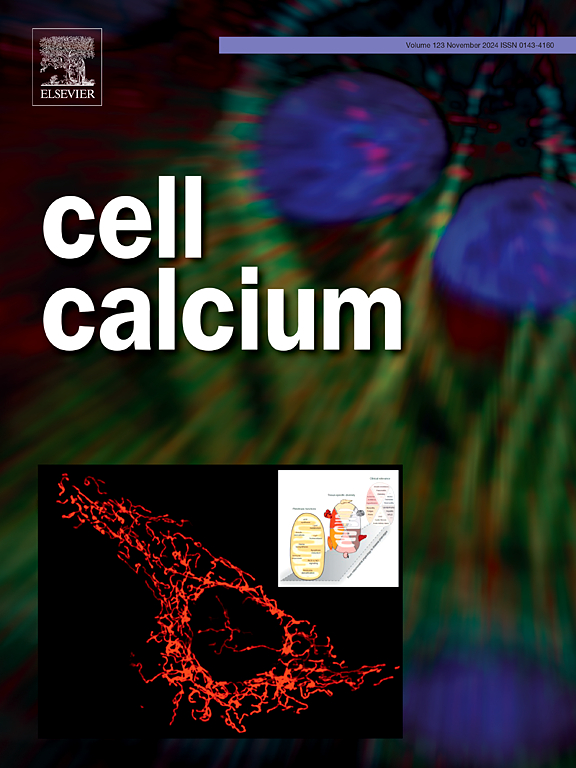Pathological calcium influx through amyloid beta pores disrupts synaptic function
IF 4
2区 生物学
Q2 CELL BIOLOGY
引用次数: 0
Abstract
Alzheimer's disease (AD) is characterized by profound disruption of synaptic function, with mounting evidence suggesting that amyloid-β (Aβ) oligomers disrupt calcium (Ca2+) homeostasis through membrane pore formation. While these pores are known to alter intracellular Ca2+ dynamics, their immediate impact on synaptic transmission and potential interaction with Familial AD (FAD)-associated endoplasmic reticulum (ER) dysfunction remains unclear. Here, we extend our previously developed model of presynaptic Ca2+ dynamics to examine how Aβ pores alter exocytosis and how such disruptions may manifest in the presence of FAD-associated ER dysfunction. Our model reveals that Aβ pores fundamentally alter both the timing and strength of neurotransmitter release. Unexpectedly, the impact of pores on synaptic function depends critically on their pattern of activity, where continuous pore activity leads to synaptic hyperactivation, while brief periods of intense pore activity trigger lasting hypoactivation at short timescales. These effects manifest most strongly in synapses with low and intermediate release probabilities, highlighting the established selective vulnerability of such synaptic configurations. We find that Aβ pores and FAD-driven ER Ca²⁺ dysregulation form an integrated pathological unit through bidirectional coupling of their respective Ca²⁺ microdomains to create complex patterns of disruptions. This coupling creates a feedback loop that produces an additive effect on neurotransmitter release during brief stimulations, but non-additive effects during sustained activity that promotes a shift towards asynchronous release. Surprisingly, our simulations predict that extended pore activity does not worsen indefinitely but only produces a modest additional disruption beyond initial pore formation that is likely determined by the intrinsic properties of the synapse. These findings indicate that early synaptic dysfunction in AD may arise from subtle perturbations in the temporal coordination of release rather than gross Ca2+ dysregulation, providing new mechanistic insights into the progressive nature of Aβ-driven synaptic failure in AD.

病理性钙通过淀粉样蛋白孔流入破坏突触功能
阿尔茨海默病(AD)的特点是突触功能严重破坏,越来越多的证据表明淀粉样蛋白-β (Aβ)寡聚物通过膜孔形成破坏钙(Ca2+)稳态。虽然已知这些孔可以改变细胞内Ca2+动力学,但它们对突触传递的直接影响以及与家族性AD (FAD)相关的内质网(ER)功能障碍的潜在相互作用仍不清楚。在这里,我们扩展了我们之前开发的突触前Ca2+动力学模型,以研究Aβ孔如何改变胞外分泌,以及这种破坏如何在fad相关的ER功能障碍中表现出来。我们的模型显示,Aβ孔从根本上改变了神经递质释放的时间和强度。出乎意料的是,孔对突触功能的影响主要取决于它们的活动模式,连续的孔活动导致突触过度激活,而短暂的强烈孔活动会在短时间尺度上引发持续的低激活。这些效应在低释放概率和中等释放概率的突触中表现得最强烈,突出了这种突触结构的既定选择性脆弱性。我们发现Aβ孔隙和fad驱动的ER Ca 2 +失调通过各自Ca 2 +微域的双向耦合形成了一个完整的病理单元,形成了复杂的破坏模式。这种耦合创造了一个反馈回路,在短暂刺激期间对神经递质释放产生加性效应,但在持续活动期间产生非加性效应,促进向异步释放转变。令人惊讶的是,我们的模拟预测,扩展的孔隙活动不会无限期地恶化,而只会在初始孔隙形成之外产生适度的额外破坏,这可能是由突触的内在特性决定的。这些发现表明,阿尔茨海默病的早期突触功能障碍可能源于释放时间协调的细微扰动,而不是总的Ca2+失调,这为阿尔茨海默病中a β驱动的突触衰竭的进行性本质提供了新的机制见解。
本文章由计算机程序翻译,如有差异,请以英文原文为准。
求助全文
约1分钟内获得全文
求助全文
来源期刊

Cell calcium
生物-细胞生物学
CiteScore
8.70
自引率
5.00%
发文量
115
审稿时长
35 days
期刊介绍:
Cell Calcium covers the field of calcium metabolism and signalling in living systems, from aspects including inorganic chemistry, physiology, molecular biology and pathology. Topic themes include:
Roles of calcium in regulating cellular events such as apoptosis, necrosis and organelle remodelling
Influence of calcium regulation in affecting health and disease outcomes
 求助内容:
求助内容: 应助结果提醒方式:
应助结果提醒方式:


